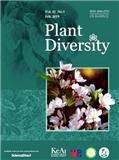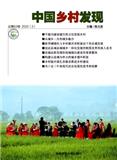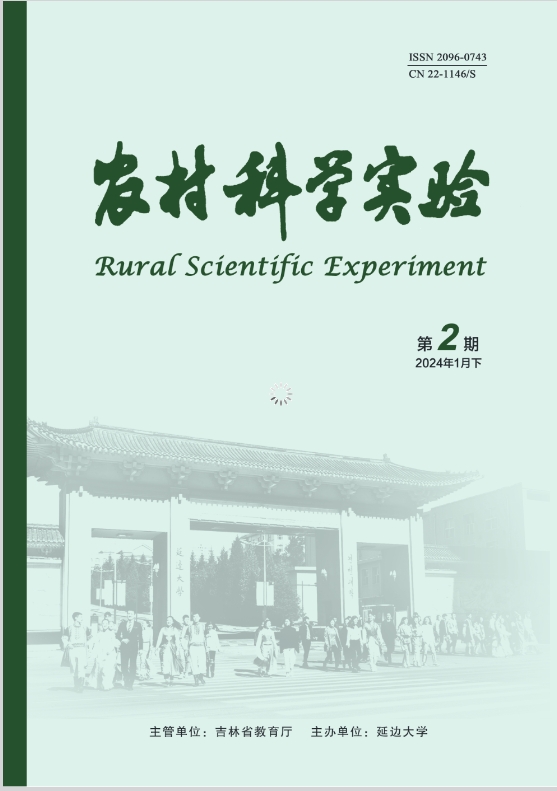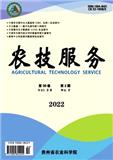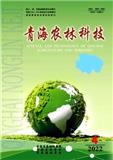农业科学学报(英文版)(Journal of Integrative Agriculture)(原:中国农业科学(英文)(Agricultural Sciences in China))杂志栏目及论文类型发文方向
/有基金 100.0%
农业科学学报(英文版)(Journal of Integrative Agriculture)(原:中国农业科学(英文)(Agricultural Sciences in China))杂志征稿要求
1、投稿方式:在线投稿。
2、刊内网址:(202308期)
http://www.ChinaAgriSci.com
http://www.sciencedirect.com/science/journal/20953119
3、投稿系统:
http://mc03.manuscriptcentral.com/asic
4、出刊日期:月刊,每月20日出版。
2023年9月13星期三
《农业科学学报(英文)》投稿须知
【官网信息】
2023-01-01
Instruction to Authors
Description
Journal of Integrative Agriculture (JIA), formerly Agricultural
Sciences in China (ASC), founded in 2002, is sponsored by Chinese
Academy of Agricultural Sciences (CAAS), co-sponsored by Chinese
Association of Agricultural Science Societies (CAASS). JIA is a
peer-reviewed and multi-disciplinary international journal and published
monthly in English. JIA Editorial Board consists of 294 well-respected
scholars of agricultural scientific fields. Prof. WU Kong-ming is the
Chairman of the Board, and Prof. CHEN Hua-lan is the Editor-in-Chief.
JIA has been published by Elsevier B.V. since 2006 and is a leading
academic journal in agricultural sciences in China. As released by JCR,
the latest IF of the journal is 4.8.
Published
articles of JIA are available both in print and electronic copies. The
electronic full texts are available on ScienceDirect
(http://www.sciencedirect.com/science/journal/20953119).
Mission
JIA promotes research and exchange of novel scientific discoveries and
ideas for the advancement of agricultural sciences. The journal
emphasizes inter-disciplinary and systematic approaches addressing
agricultural life science, agricultural sustainability, food science,
agricultural environment, ecology and energy, therefore to concern for
human health and development around the globe.
Aims
& Scope JIA seeks to publish those papers that are influential and
will significantly advance scientific understanding in agriculture
fields worldwide. JIA publishes manuscripts in the five categories
focusing on the core subjects listed below.
Peer
Review This journal operates a double-blind review process. All
contributions will be initially assessed by the Managing editor and
Section editor for suitability for the journal. Papers deemed suitable
are then sent to a minimum of two independent expert reviewers to assess
the scientific quality of the paper.
Categories
Commentary
section is a platform to exchange viewpoints, praise and criticism each
other in the agricultural science community. Authors may submit
comments in regard to the contents published previously in JIA or bring
up other issues that may be of interest and relevant to JIA. Commentary
will appear at the beginning of the issue with no abstract or keywords.
Review
describes new development and highlight future directions of a
specialized or interdisciplinary significance in agriculture sciences.
They should be focused on providing insights and summary/context on the
published findings and introducing some new concepts or viewpoints for
solving the important unresolved questions by presenting the research
background, approach, and outlook of the field. Only invited Reviews
are considered.
Research
Article presents important new research results through reproducible
experimental design, using genetic, biochemical, cell and molecular
biological methods, statistical analyses, and other scientific methods.
Short
Communication is for a concise, but independent report representing a
significant contribution to agriculture sciences. It is intended to
publish these results that are exceptional interest and particularly
topical and relevant, but the preliminary results. It should be limited
to 2 500 words, and could include no more than two figures or tables.
Letter
needs no more than 1 500 words, can include one figure and one table,
other figures and tables can be submitted online as appendices.
Core Subjects
— Crop Science
— Horticulture
— Plant Protection
— Animal Science
— Veterinary Medicine
— Agro-ecosystem & Eniverionment
— Food Science
— Agricultural Economics and Management
— Agricultural Information Science
Indexing
JIA has been indexed by SCI, Abstract Journal (AJ), Zoological Record
(ZR), Food Science and Technology Abstracts (FSTA), CABI, Scopus, and
the main periodical databases in China.
Copyright
© 2023, Chinese Academy of Agricultural Sciences (CAAS). By your
submission of this work and effectively at our acceptance for
publication, you hereby assign rights of the manuscript identified
above and any tables, illustrations and other materials submitted for
publication as part of the manuscript—including but not limited to
copyrights, distribution rights, information network dissemination
rights, broadcasting rights, performance rights, translation rights,
compilation rights, adaptation rights and other copyright property
rights, in print, electronic and all other media, in any form, in all
languages, all over the world, and the rights to license others to do
the same, exclusively to CAAS.
Submission
of a manuscript implies that the submitted work has not been published
before (except as part of a thesis or lecture note or report, or in the
form of an abstract); that it is not under consideration for publication
elsewhere; that its publication has been approved by all co-authors as
well as by the authorities at the institute where the work has been
carried out; that once acceptance, transfer of copyright to the CAAS
will be required, and that the manuscript or parts thereof will thus not
be published elsewhere in any language without the consent of the
copyright holder. Authors will have the right to share their article in
the same ways permitted to third parties under the relevant user
license, as well as certain scholarly usage rights.
Acceptance
The acceptance of a paper implies that it has been reviewed and
recommended by at least two reviewers, of which one is from the
Editorial Board as a super reviewer. Authors will generally be notified
of acceptance, rejection, or need for revision within two months of
receipt. The accepted papers will be published in a chronological order.
Submission
An electronic file of a manuscript with original figures, along with a
cover letter to the editors, should be submitted online to JIA by
accessing http://www.ChinaAgriSci.com. All submitted manuscripts will
undergo the plagiarism checking via the Crossref Similarity Check. And
for any question involved, please feel free to contact us:
Editorial Office of Journal of Integrative Agriculture
No. 12 Zhongguancun South Street
Beijing 100081, P.R.China
Tel: +86-10-82105098, 82106279, 82106280
Fax: +86-10-82106247
E-mail: jia_journal@caas.cn
Website: http://www.ChinaAgriSci.com
Potential
reviewers Authors are encouraged to provide a list of potential
reviewers. Reviewers must not be subject to a conflict of interest
involving the author(s) or manuscript(s). The editors of JIA are not
obligated to use any reviewer suggested by the author(s).
Creating
the manuscript Microsoft Word files are required for all manuscripts.
Generally, the manuscript should be arranged in the following sections
and appear in order: Title, Abstract and Keywords, Introduction,
Materials and methods, Results, Discussion, Conclusion,
Acknowledgements, Confilict of interest, Ethical aproval (if involved)
and References.
All
manuscripts must be written in clear and grammaticaly correct English.
Scientific language, nomenclature and standard international units
should be used.
The
title page should include: title of the article, full name,
institution(s) and address(es) of author(s); the first author’s
professional title and degree; and correspondence’s detailed postal and
e-mail addresses and phone and fax numbers. For authors in China, the
information mentioned above in Chinese is required.
If
the work involves the use of animal subjects, the author should ensure
that the manuscript contains a statement that all procedures were
performaed in compliance with revelant laws and institutional guidelines
and the approatiate instituional comittee(s) has approved them.
Acknowledgements
should be a brief statement at the end of the text and may include
source of financial support. The contract No. should be provided.
References
Author-year citations are required. Give the author’s name followed by
the year of publication in the text, i.e., (Crews and Davies 1986).
Where there are more than two authors, only the first should be named
followed by et al., i.e., (Cataldo et al. 1983). Where there are more
than one citation in the parentheses the “;” should be used (Obata and
Umebayashi 1997; Yang et al. 1998), but if it is the same author, the
“,” should be used (Smith 2000, 2002). Reference to unpublished data
and personal communication should not appear in the list but should be
cited in the text only (e.g., Clarke J M 2015, personal communication;
Wang G P 2017, unpublished data). In the reference list, the references
should be listed in an alphabetical order. Names of journals should be
in italic in full titles rather than the abbreviation. The following
examples are for guidance.
Chen
W F, Xu Z J, Zhang L B, Zhang W Z, Ma D R. 2007. Theories and practices
of breeding japonica rice for super high yield. Scientia Agricultura
Sinica, 40, 869–874. (in Chinese)
Cousins I T, Mackay D. 2001. Strategies for including vegetation compartments in multimedia models.Chemosphere, 44, 643–654.
Dababat
A A, Fourie H. 2018. Nematode parasite of cereals. In: Sikora R A,
Coyne D, Hallmann J, Timper P, eds., Plant Parasitic Nematodes in
Subtropical and Tropical Agriculture. CABI Publishing, Wallingford, UK.
pp. 163–200.
FAO
(Food and Agriculture Organization). 2015. Online statistical database:
Food balance. FAOSTAT. [2015-12-02].
http://faostat3.fao.org/download/FB/*/E
GB/T 17891-1999. 1999. High Quality Paddy Rice. National Standard of the People’s Republic of China. (in Chinese)
Zhang
H M, Wang B R, Xu M G, Fan T L. 2009a. Crop yield and soil responses to
long-term fertilization on a red soil in southern China. Pedosphere,
19, 199–207.
Zhang
H M, Xu M G, Zhang F. 2009b. Long-term effects of manure application on
grain yield under different cropping systems and ecological conditions
in China. Journal of Agricultural Science, 147, 31–42.
Wu
Y, Taliaferro C M. 2012. Switchgrass Cultivar. U.S. Patent, Application
No. 8278500. Patent and Trademark Office, Washington, D.C., USA.
Tables should be numbered consecutively and accompanied by a title at the top.
Illustrations
Do not use figures that duplicate matter in tables. Figures can be
supplied in digital format, or photographs and drawings, which can be
ready, or with source data, for reproduction. Label each figure with
figure number consecutively. Figure legends should be grouped on a
separate page. Authors can publish colour photos, firgures, or maps at
their own expense.
Handling
and Printing fee of CNY600 per page for the first 10 pages, CNY650 per
page for the subsequent pages, and CNY1500 per color plate will be
charged for all the manuscrips accepted. No charge for B/W figures. The
evaluating fee of CNY300 is charged for each paper.
Open
Access fee JIA is a fully Open Access (OA) journal on ScienceDirect and
all the accepted articles are published OA. The OA fee could be covered
by JIA (CAAS) via author's applying a waiver when submitting a paper.
Proofs
will be sent to the corresponding author by e-mail as PDF files for
checking and correcting of typographical errors. To avoid delay in
publication, proofs should be returned in 72 hours.
Free providing Two copies of the printed journal will be provided to authors free of charge.
Reprints may be purchased by ordering in advance when sending back the proof by e-mail as CNY2 for each copy.
Reporting sex- and gender-based analyses
Reporting guidance
For
research involving or pertaining to humans, animals or eukaryotic
cells, investigators should integrate sex and gender-based analyses
(SGBA) into their research design according to funder/sponsor
requirements and best practices within a field. Authors should address
the sex and/or gender dimensions of their research in their article. In
cases where they cannot, they should discuss this as a limitation to
their research's generalizability. Importantly, authors should
explicitly state what definitions of sex and/or gender they are applying
to enhance the precision, rigor and reproducibility of their research
and to avoid ambiguity or conflation of terms and the constructs to
which they refer (see Definitions section below). Authors can refer to
the Sex and Gender Equity in Research (SAGER) guidelines and the SAGER
guidelines checklist. These offer systematic approaches to the use and
editorial review of sex and gender information in study design, data
analysis, outcome reporting and research interpretation - however,
please note there is no single, universally agreedupon set of guidelines
for defining sex and gender.
Definitions
Sex
generally refers to a set of biological attributes that are associated
with physical and physiological features (e.g., chromosomal genotype,
hormonal levels, internal and external anatomy). A binary sex
categorization (male/female) is usually designated at birth ("sex
assigned at birth"), most often based solely on the visible external
anatomy of a newborn. Gender generally refers to socially constructed
roles, behaviors, and identities of women, men and gender-diverse people
that occur in a historical and cultural context and may vary across
societies and over time. Gender influences how people view themselves
and each other, how they behave and interact and how power is
distributed in society. Sex and gender are often incorrectly portrayed
as binary (female/male or woman/man) and unchanging whereas these
constructs actually exist along a spectrum and include additional sex
categorizations and gender identities such as people who are
intersex/have differences of sex development (DSD) or identify as
non-binary. Moreover, the terms "sex" and "gender" can be ambiguous?thus
it is important for authors to define the manner in which they are
used. In addition to this definition guidance and the SAGER guidelines,
the resources on this page offer further insight around sex and gender
in research studies.
Disclaimer
No responsibility is assumed by Publisher (Elsevier B.V.), nor by the
Organization (Chinese Academy of Agricultural Sciences), nor by the
Editors for any injury and/or damage to persons or property as a result
of any actual or alleged libellous statements, infringement of
intellectual property or privacy rights, or products liability, whether
resulting from negligence or otherwise, or from any use or operation of
any ideas, instructions, procedures, products or methods contained in
the material therein. The publication of an advertisement in the Journal
of Integrative Agriculture does not constitute on the part of Publisher
or the Organization a guarantee or endorsement of the quality or value
of the advertised products or services described therein or of any of
the representations or the claims made by the advertisers with respect
to such products or services.

